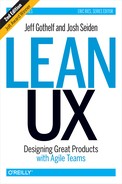Part II. Process
It’s Tuesday, and Rick, Mark, Olga, and Arti are standing at the whiteboard, looking at a wireframe that they’ve drawn. Arti has a marker in her hand, but she’s not drawing. “Rick, I don’t understand what you’re driving at. Can you explain the problem?” she asks.
Rick takes the marker, wipes clear a section of the board, and explains the regulation, again. The team is designing an app for stock traders, and the app must obey a strict set of regulations. Rick, the business analyst, is responsible for making sure that the team’s designs support the rules.
After a while, the team is nodding, and Arti takes the marker again. She suggests a change to the wireframe design of the app on the board and the team nods again. They all take out their iPhones, take photos of the board, and agree to reconvene the next day. They’re confident that what they’ve agreed on will be ready for user-testing on Thursday.
Arti, the designer, goes back to her desk to begin detailing out the design they’ve sketched. Mark, the frontend developer, begins building the page—he uses components from the Design System the team has built, so he doesn’t need to wait for Arti before getting the basic pieces in place. Rick opens the project’s wiki page and begins to document the decisions the team has made about the application’s behavior. He’ll review these choices with the product owner later in the day. And Olga, the QA tester, begins the process of writing tests for the new section of the app.
This is the day-to-day rhythm of Lean UX: a team working collaboratively, iteratively, and in parallel, with few handoffs, minimal deliverables, and a focus on working software and market feedback. In this section, you’ll see how it’s done.
About Part II
In the previous part, we looked at the ideas behind Lean UX—the principles that drive the work. In this section, we get very practical and describe in detail the process of doing Lean UX.
The Lean UX Process
Chapter 3 describes how to frame our work. Lean UX radically shifts the way we frame our work. Our goal is not to create a deliverable. It’s to change something in the world—to create an outcome. In this chapter, we describe the key tools we use to do this: hypothesis statements.
Chapter 4 describes the shift in our design process. Lean UX uses many techniques familiar to designers but shifts the emphasis of our work. We become more collaborative. We aim for speed first. We prioritize learning. We use a key tool to achieve this: the Minimum Viable Product.
Chapter 5 is about experiments. Lean UX is based on the idea that we begin our work with an assumption. We use experiments to test our assumptions and then build on what we learn in those experiments. This chapter shows you how to orient your design process around experiments and learning.
Chapter 6 is about feedback. UX in any form requires good input from users. Lean UX puts a premium on continuous feedback to help guide our design process. This chapter shows you techniques that Lean UX teams use to get feedback early and often and how to incorporate that feedback into future product iterations.
